Business and the Business Environment Analysis Report: Unilever
VerifiedAdded on 2020/10/05
|17
|5848
|166
Report
AI Summary
This report provides a comprehensive analysis of Unilever's business environment, covering various aspects such as organizational types (private, public, and voluntary sectors), legal structures, and the size and scope of different organizations. It delves into the relationship between organizational functions, including operation management, and their interrelation with organizational objectives. The report also examines the positive and negative impacts of the macro environment on business operations, along with internal and external analysis to identify strengths and weaknesses, and how these relate to external macro factors. The analysis uses Unilever as a case study, examining its operations within the context of the business environment. The report explores the different organizational structures, including functional, divisional, and matrix structures, and how they affect the company's operations and goals. Finally, the report also discusses the legal structures of private, public, and voluntary sectors and the codes of conduct that companies need to follow.
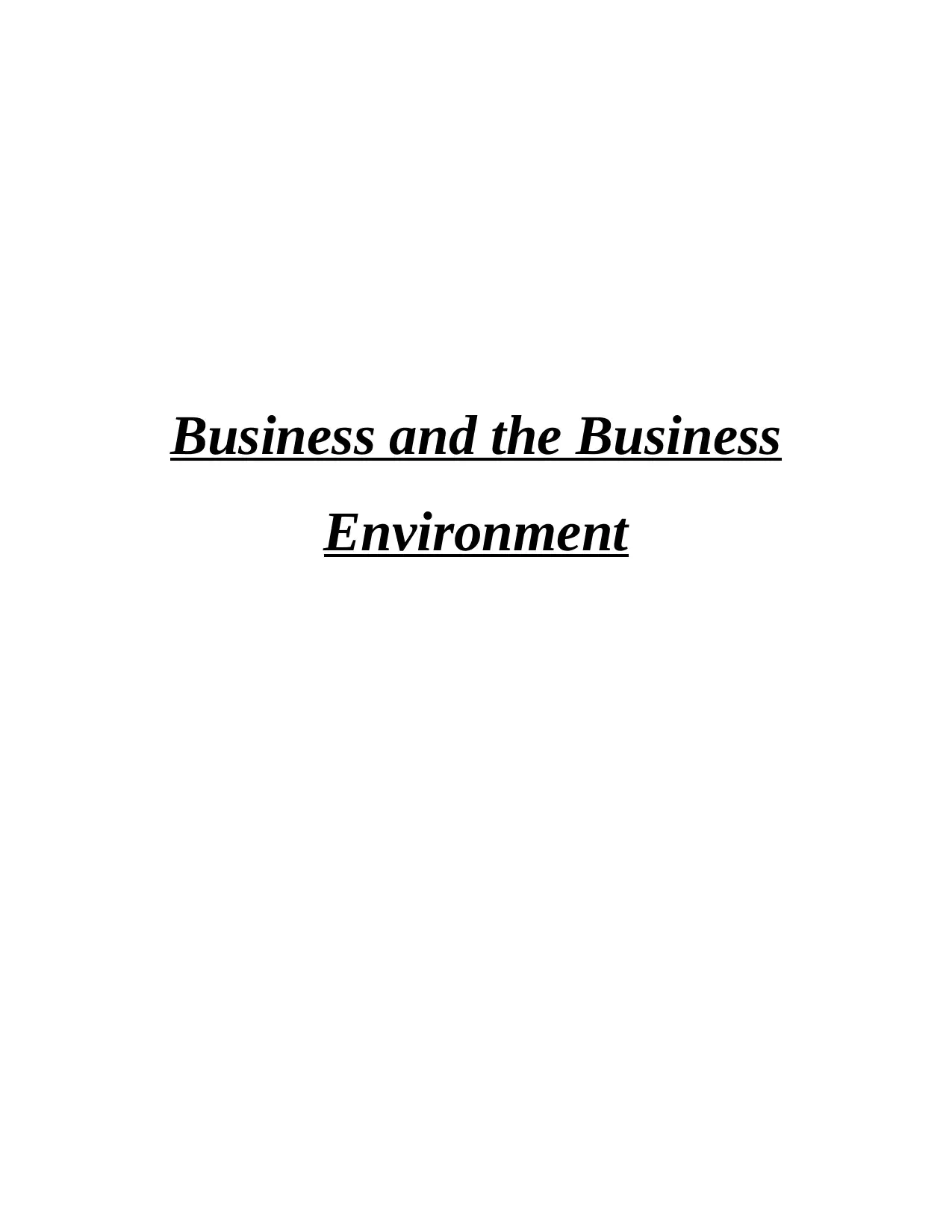
Business and the Business
Environment
Environment
Paraphrase This Document
Need a fresh take? Get an instant paraphrase of this document with our AI Paraphraser
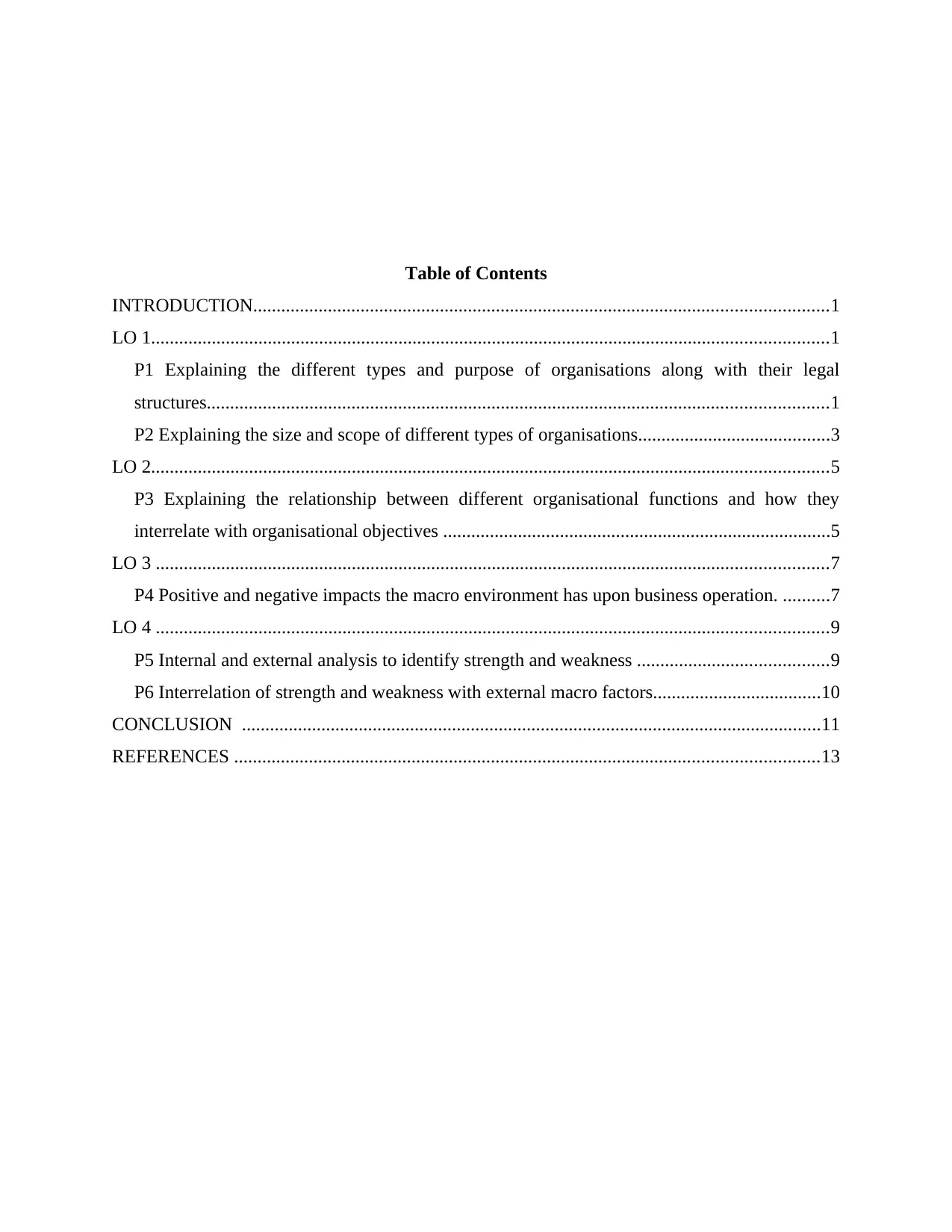
Table of Contents
INTRODUCTION...........................................................................................................................1
LO 1.................................................................................................................................................1
P1 Explaining the different types and purpose of organisations along with their legal
structures.....................................................................................................................................1
P2 Explaining the size and scope of different types of organisations.........................................3
LO 2.................................................................................................................................................5
P3 Explaining the relationship between different organisational functions and how they
interrelate with organisational objectives ...................................................................................5
LO 3 ................................................................................................................................................7
P4 Positive and negative impacts the macro environment has upon business operation. ..........7
LO 4 ................................................................................................................................................9
P5 Internal and external analysis to identify strength and weakness .........................................9
P6 Interrelation of strength and weakness with external macro factors....................................10
CONCLUSION ............................................................................................................................11
REFERENCES .............................................................................................................................13
INTRODUCTION...........................................................................................................................1
LO 1.................................................................................................................................................1
P1 Explaining the different types and purpose of organisations along with their legal
structures.....................................................................................................................................1
P2 Explaining the size and scope of different types of organisations.........................................3
LO 2.................................................................................................................................................5
P3 Explaining the relationship between different organisational functions and how they
interrelate with organisational objectives ...................................................................................5
LO 3 ................................................................................................................................................7
P4 Positive and negative impacts the macro environment has upon business operation. ..........7
LO 4 ................................................................................................................................................9
P5 Internal and external analysis to identify strength and weakness .........................................9
P6 Interrelation of strength and weakness with external macro factors....................................10
CONCLUSION ............................................................................................................................11
REFERENCES .............................................................................................................................13
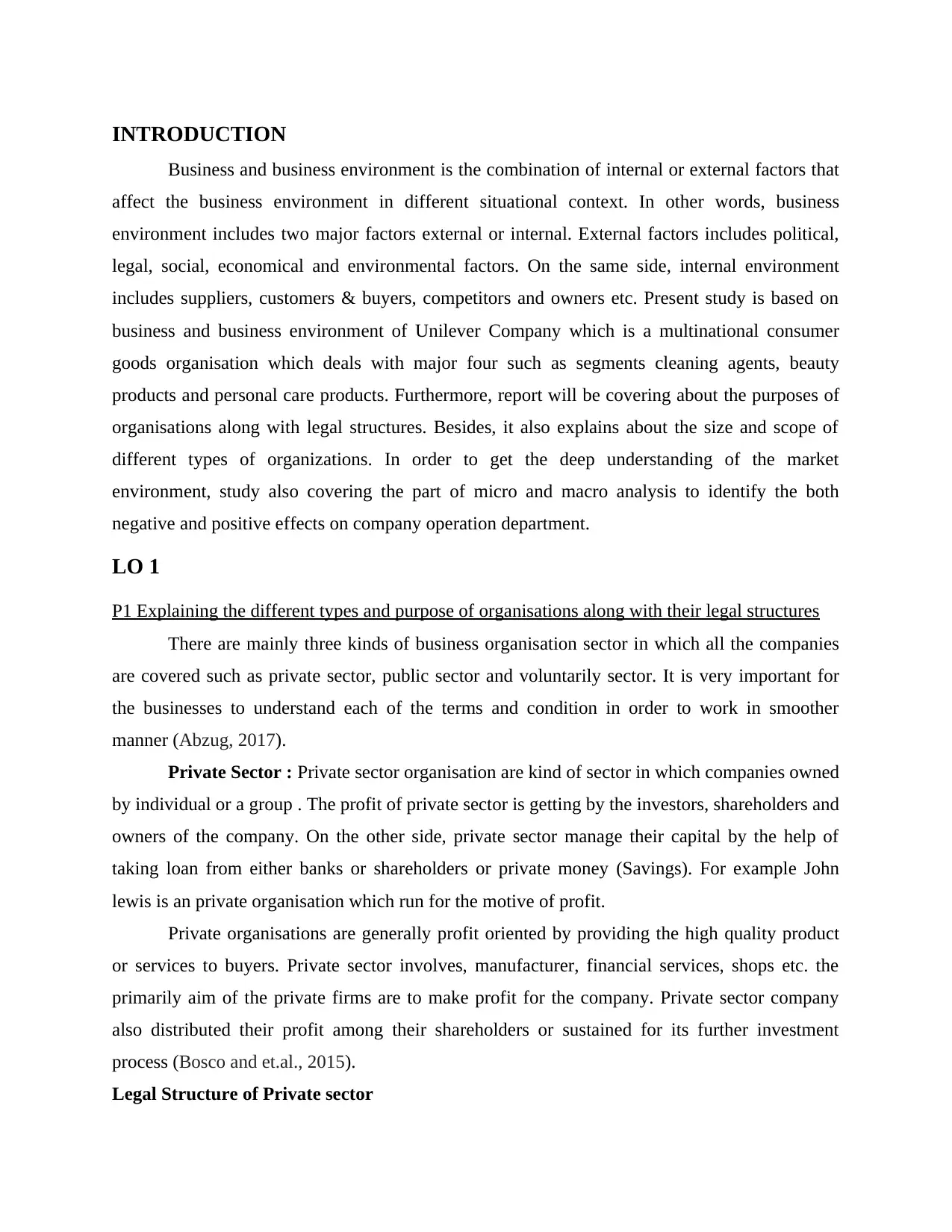
INTRODUCTION
Business and business environment is the combination of internal or external factors that
affect the business environment in different situational context. In other words, business
environment includes two major factors external or internal. External factors includes political,
legal, social, economical and environmental factors. On the same side, internal environment
includes suppliers, customers & buyers, competitors and owners etc. Present study is based on
business and business environment of Unilever Company which is a multinational consumer
goods organisation which deals with major four such as segments cleaning agents, beauty
products and personal care products. Furthermore, report will be covering about the purposes of
organisations along with legal structures. Besides, it also explains about the size and scope of
different types of organizations. In order to get the deep understanding of the market
environment, study also covering the part of micro and macro analysis to identify the both
negative and positive effects on company operation department.
LO 1
P1 Explaining the different types and purpose of organisations along with their legal structures
There are mainly three kinds of business organisation sector in which all the companies
are covered such as private sector, public sector and voluntarily sector. It is very important for
the businesses to understand each of the terms and condition in order to work in smoother
manner (Abzug, 2017).
Private Sector : Private sector organisation are kind of sector in which companies owned
by individual or a group . The profit of private sector is getting by the investors, shareholders and
owners of the company. On the other side, private sector manage their capital by the help of
taking loan from either banks or shareholders or private money (Savings). For example John
lewis is an private organisation which run for the motive of profit.
Private organisations are generally profit oriented by providing the high quality product
or services to buyers. Private sector involves, manufacturer, financial services, shops etc. the
primarily aim of the private firms are to make profit for the company. Private sector company
also distributed their profit among their shareholders or sustained for its further investment
process (Bosco and et.al., 2015).
Legal Structure of Private sector
Business and business environment is the combination of internal or external factors that
affect the business environment in different situational context. In other words, business
environment includes two major factors external or internal. External factors includes political,
legal, social, economical and environmental factors. On the same side, internal environment
includes suppliers, customers & buyers, competitors and owners etc. Present study is based on
business and business environment of Unilever Company which is a multinational consumer
goods organisation which deals with major four such as segments cleaning agents, beauty
products and personal care products. Furthermore, report will be covering about the purposes of
organisations along with legal structures. Besides, it also explains about the size and scope of
different types of organizations. In order to get the deep understanding of the market
environment, study also covering the part of micro and macro analysis to identify the both
negative and positive effects on company operation department.
LO 1
P1 Explaining the different types and purpose of organisations along with their legal structures
There are mainly three kinds of business organisation sector in which all the companies
are covered such as private sector, public sector and voluntarily sector. It is very important for
the businesses to understand each of the terms and condition in order to work in smoother
manner (Abzug, 2017).
Private Sector : Private sector organisation are kind of sector in which companies owned
by individual or a group . The profit of private sector is getting by the investors, shareholders and
owners of the company. On the other side, private sector manage their capital by the help of
taking loan from either banks or shareholders or private money (Savings). For example John
lewis is an private organisation which run for the motive of profit.
Private organisations are generally profit oriented by providing the high quality product
or services to buyers. Private sector involves, manufacturer, financial services, shops etc. the
primarily aim of the private firms are to make profit for the company. Private sector company
also distributed their profit among their shareholders or sustained for its further investment
process (Bosco and et.al., 2015).
Legal Structure of Private sector
⊘ This is a preview!⊘
Do you want full access?
Subscribe today to unlock all pages.

Trusted by 1+ million students worldwide
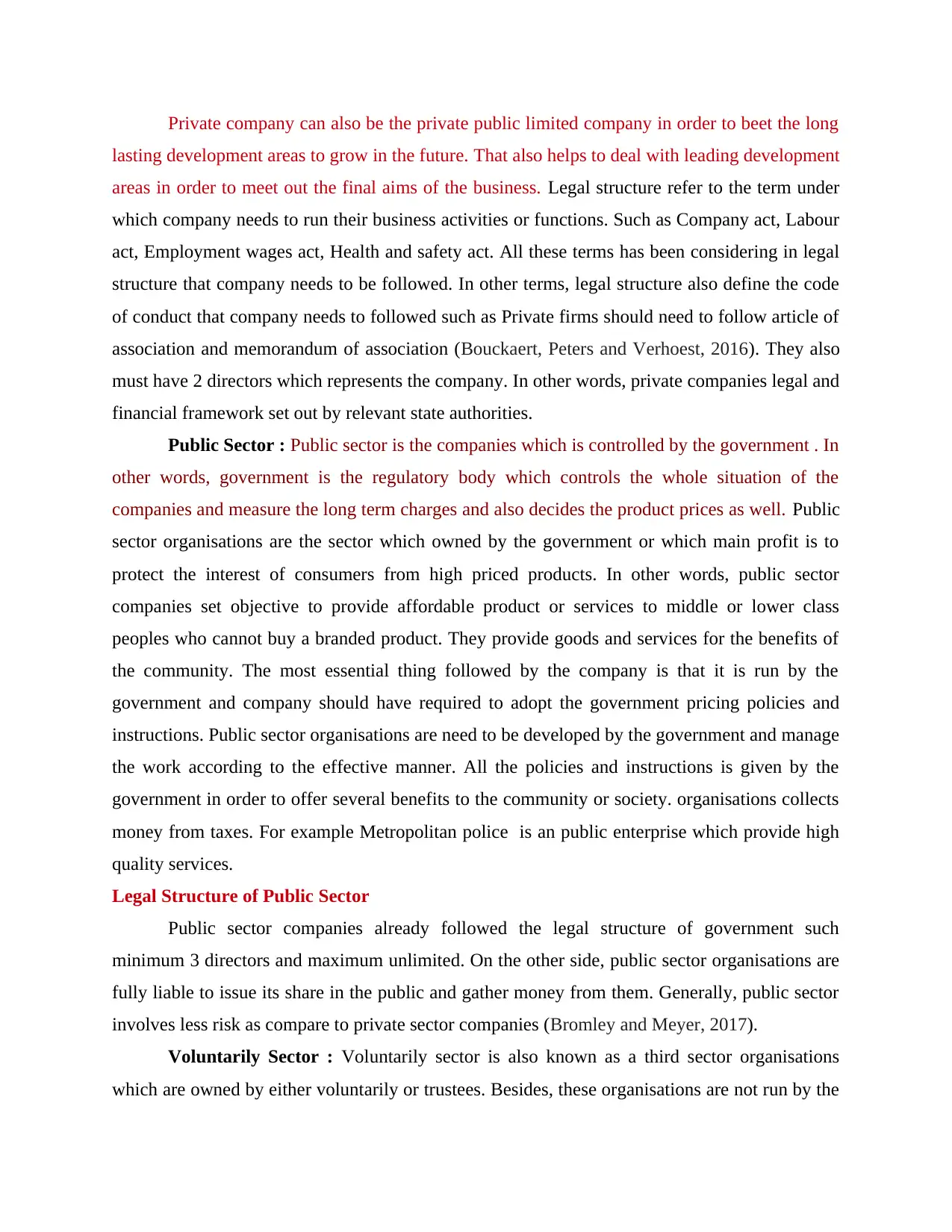
Private company can also be the private public limited company in order to beet the long
lasting development areas to grow in the future. That also helps to deal with leading development
areas in order to meet out the final aims of the business. Legal structure refer to the term under
which company needs to run their business activities or functions. Such as Company act, Labour
act, Employment wages act, Health and safety act. All these terms has been considering in legal
structure that company needs to be followed. In other terms, legal structure also define the code
of conduct that company needs to followed such as Private firms should need to follow article of
association and memorandum of association (Bouckaert, Peters and Verhoest, 2016). They also
must have 2 directors which represents the company. In other words, private companies legal and
financial framework set out by relevant state authorities.
Public Sector : Public sector is the companies which is controlled by the government . In
other words, government is the regulatory body which controls the whole situation of the
companies and measure the long term charges and also decides the product prices as well. Public
sector organisations are the sector which owned by the government or which main profit is to
protect the interest of consumers from high priced products. In other words, public sector
companies set objective to provide affordable product or services to middle or lower class
peoples who cannot buy a branded product. They provide goods and services for the benefits of
the community. The most essential thing followed by the company is that it is run by the
government and company should have required to adopt the government pricing policies and
instructions. Public sector organisations are need to be developed by the government and manage
the work according to the effective manner. All the policies and instructions is given by the
government in order to offer several benefits to the community or society. organisations collects
money from taxes. For example Metropolitan police is an public enterprise which provide high
quality services.
Legal Structure of Public Sector
Public sector companies already followed the legal structure of government such
minimum 3 directors and maximum unlimited. On the other side, public sector organisations are
fully liable to issue its share in the public and gather money from them. Generally, public sector
involves less risk as compare to private sector companies (Bromley and Meyer, 2017).
Voluntarily Sector : Voluntarily sector is also known as a third sector organisations
which are owned by either voluntarily or trustees. Besides, these organisations are not run by the
lasting development areas to grow in the future. That also helps to deal with leading development
areas in order to meet out the final aims of the business. Legal structure refer to the term under
which company needs to run their business activities or functions. Such as Company act, Labour
act, Employment wages act, Health and safety act. All these terms has been considering in legal
structure that company needs to be followed. In other terms, legal structure also define the code
of conduct that company needs to followed such as Private firms should need to follow article of
association and memorandum of association (Bouckaert, Peters and Verhoest, 2016). They also
must have 2 directors which represents the company. In other words, private companies legal and
financial framework set out by relevant state authorities.
Public Sector : Public sector is the companies which is controlled by the government . In
other words, government is the regulatory body which controls the whole situation of the
companies and measure the long term charges and also decides the product prices as well. Public
sector organisations are the sector which owned by the government or which main profit is to
protect the interest of consumers from high priced products. In other words, public sector
companies set objective to provide affordable product or services to middle or lower class
peoples who cannot buy a branded product. They provide goods and services for the benefits of
the community. The most essential thing followed by the company is that it is run by the
government and company should have required to adopt the government pricing policies and
instructions. Public sector organisations are need to be developed by the government and manage
the work according to the effective manner. All the policies and instructions is given by the
government in order to offer several benefits to the community or society. organisations collects
money from taxes. For example Metropolitan police is an public enterprise which provide high
quality services.
Legal Structure of Public Sector
Public sector companies already followed the legal structure of government such
minimum 3 directors and maximum unlimited. On the other side, public sector organisations are
fully liable to issue its share in the public and gather money from them. Generally, public sector
involves less risk as compare to private sector companies (Bromley and Meyer, 2017).
Voluntarily Sector : Voluntarily sector is also known as a third sector organisations
which are owned by either voluntarily or trustees. Besides, these organisations are not run by the
Paraphrase This Document
Need a fresh take? Get an instant paraphrase of this document with our AI Paraphraser
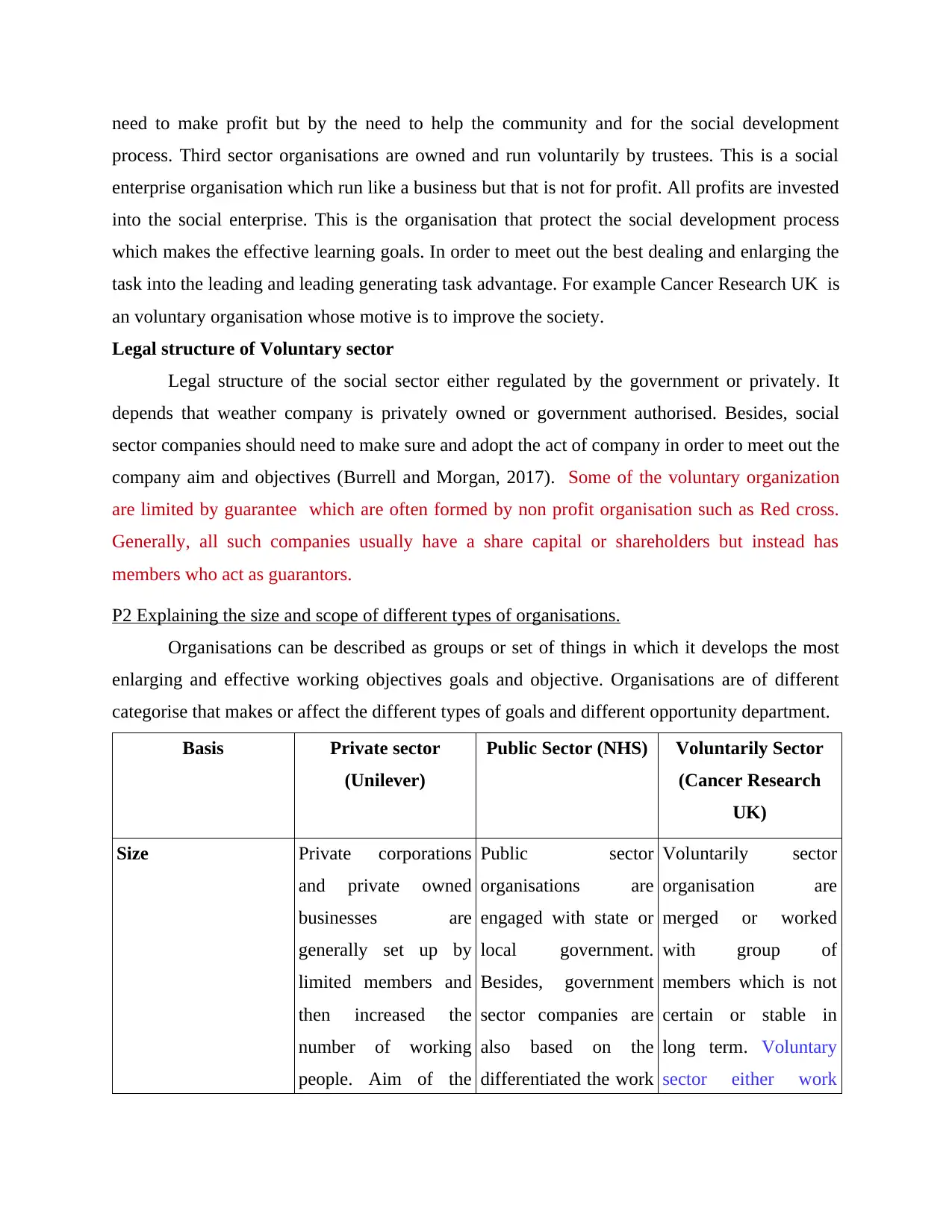
need to make profit but by the need to help the community and for the social development
process. Third sector organisations are owned and run voluntarily by trustees. This is a social
enterprise organisation which run like a business but that is not for profit. All profits are invested
into the social enterprise. This is the organisation that protect the social development process
which makes the effective learning goals. In order to meet out the best dealing and enlarging the
task into the leading and leading generating task advantage. For example Cancer Research UK is
an voluntary organisation whose motive is to improve the society.
Legal structure of Voluntary sector
Legal structure of the social sector either regulated by the government or privately. It
depends that weather company is privately owned or government authorised. Besides, social
sector companies should need to make sure and adopt the act of company in order to meet out the
company aim and objectives (Burrell and Morgan, 2017). Some of the voluntary organization
are limited by guarantee which are often formed by non profit organisation such as Red cross.
Generally, all such companies usually have a share capital or shareholders but instead has
members who act as guarantors.
P2 Explaining the size and scope of different types of organisations.
Organisations can be described as groups or set of things in which it develops the most
enlarging and effective working objectives goals and objective. Organisations are of different
categorise that makes or affect the different types of goals and different opportunity department.
Basis Private sector
(Unilever)
Public Sector (NHS) Voluntarily Sector
(Cancer Research
UK)
Size Private corporations
and private owned
businesses are
generally set up by
limited members and
then increased the
number of working
people. Aim of the
Public sector
organisations are
engaged with state or
local government.
Besides, government
sector companies are
also based on the
differentiated the work
Voluntarily sector
organisation are
merged or worked
with group of
members which is not
certain or stable in
long term. Voluntary
sector either work
process. Third sector organisations are owned and run voluntarily by trustees. This is a social
enterprise organisation which run like a business but that is not for profit. All profits are invested
into the social enterprise. This is the organisation that protect the social development process
which makes the effective learning goals. In order to meet out the best dealing and enlarging the
task into the leading and leading generating task advantage. For example Cancer Research UK is
an voluntary organisation whose motive is to improve the society.
Legal structure of Voluntary sector
Legal structure of the social sector either regulated by the government or privately. It
depends that weather company is privately owned or government authorised. Besides, social
sector companies should need to make sure and adopt the act of company in order to meet out the
company aim and objectives (Burrell and Morgan, 2017). Some of the voluntary organization
are limited by guarantee which are often formed by non profit organisation such as Red cross.
Generally, all such companies usually have a share capital or shareholders but instead has
members who act as guarantors.
P2 Explaining the size and scope of different types of organisations.
Organisations can be described as groups or set of things in which it develops the most
enlarging and effective working objectives goals and objective. Organisations are of different
categorise that makes or affect the different types of goals and different opportunity department.
Basis Private sector
(Unilever)
Public Sector (NHS) Voluntarily Sector
(Cancer Research
UK)
Size Private corporations
and private owned
businesses are
generally set up by
limited members and
then increased the
number of working
people. Aim of the
Public sector
organisations are
engaged with state or
local government.
Besides, government
sector companies are
also based on the
differentiated the work
Voluntarily sector
organisation are
merged or worked
with group of
members which is not
certain or stable in
long term. Voluntary
sector either work
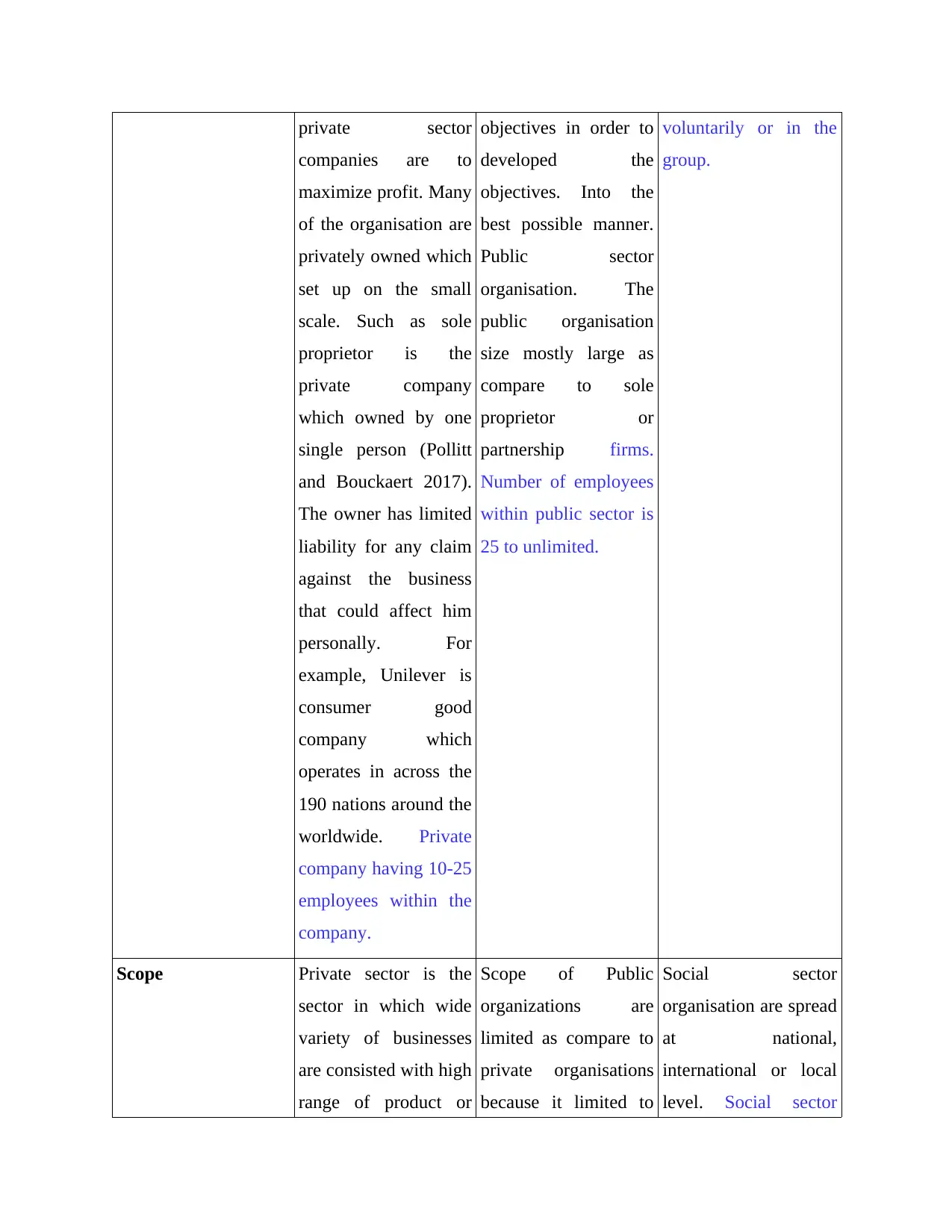
private sector
companies are to
maximize profit. Many
of the organisation are
privately owned which
set up on the small
scale. Such as sole
proprietor is the
private company
which owned by one
single person (Pollitt
and Bouckaert 2017).
The owner has limited
liability for any claim
against the business
that could affect him
personally. For
example, Unilever is
consumer good
company which
operates in across the
190 nations around the
worldwide. Private
company having 10-25
employees within the
company.
objectives in order to
developed the
objectives. Into the
best possible manner.
Public sector
organisation. The
public organisation
size mostly large as
compare to sole
proprietor or
partnership firms.
Number of employees
within public sector is
25 to unlimited.
voluntarily or in the
group.
Scope Private sector is the
sector in which wide
variety of businesses
are consisted with high
range of product or
Scope of Public
organizations are
limited as compare to
private organisations
because it limited to
Social sector
organisation are spread
at national,
international or local
level. Social sector
companies are to
maximize profit. Many
of the organisation are
privately owned which
set up on the small
scale. Such as sole
proprietor is the
private company
which owned by one
single person (Pollitt
and Bouckaert 2017).
The owner has limited
liability for any claim
against the business
that could affect him
personally. For
example, Unilever is
consumer good
company which
operates in across the
190 nations around the
worldwide. Private
company having 10-25
employees within the
company.
objectives in order to
developed the
objectives. Into the
best possible manner.
Public sector
organisation. The
public organisation
size mostly large as
compare to sole
proprietor or
partnership firms.
Number of employees
within public sector is
25 to unlimited.
voluntarily or in the
group.
Scope Private sector is the
sector in which wide
variety of businesses
are consisted with high
range of product or
Scope of Public
organizations are
limited as compare to
private organisations
because it limited to
Social sector
organisation are spread
at national,
international or local
level. Social sector
⊘ This is a preview!⊘
Do you want full access?
Subscribe today to unlock all pages.

Trusted by 1+ million students worldwide
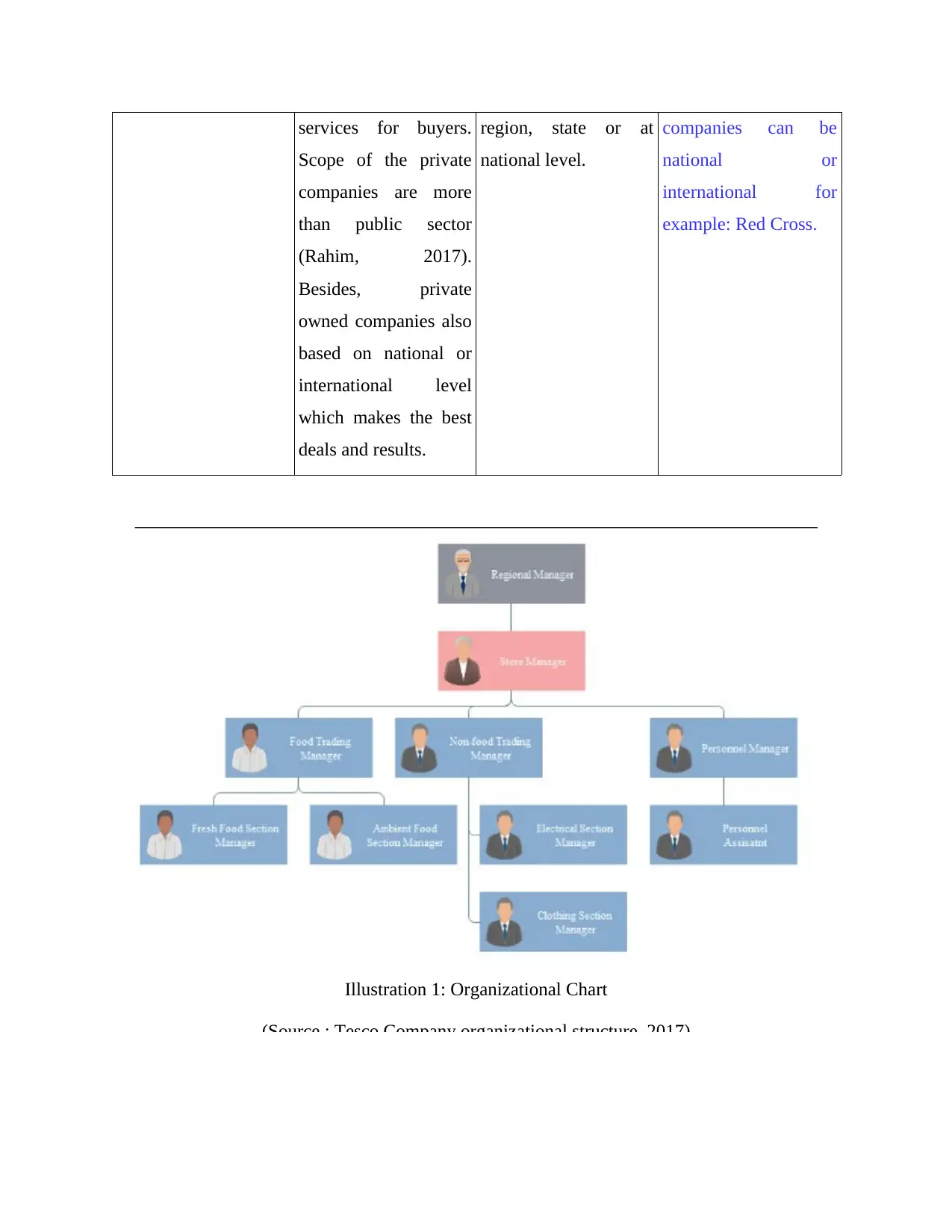
services for buyers.
Scope of the private
companies are more
than public sector
(Rahim, 2017).
Besides, private
owned companies also
based on national or
international level
which makes the best
deals and results.
region, state or at
national level.
companies can be
national or
international for
example: Red Cross.
Illustration 1: Organizational Chart
(Source : Tesco Company organizational structure. 2017)
Scope of the private
companies are more
than public sector
(Rahim, 2017).
Besides, private
owned companies also
based on national or
international level
which makes the best
deals and results.
region, state or at
national level.
companies can be
national or
international for
example: Red Cross.
Illustration 1: Organizational Chart
(Source : Tesco Company organizational structure. 2017)
Paraphrase This Document
Need a fresh take? Get an instant paraphrase of this document with our AI Paraphraser
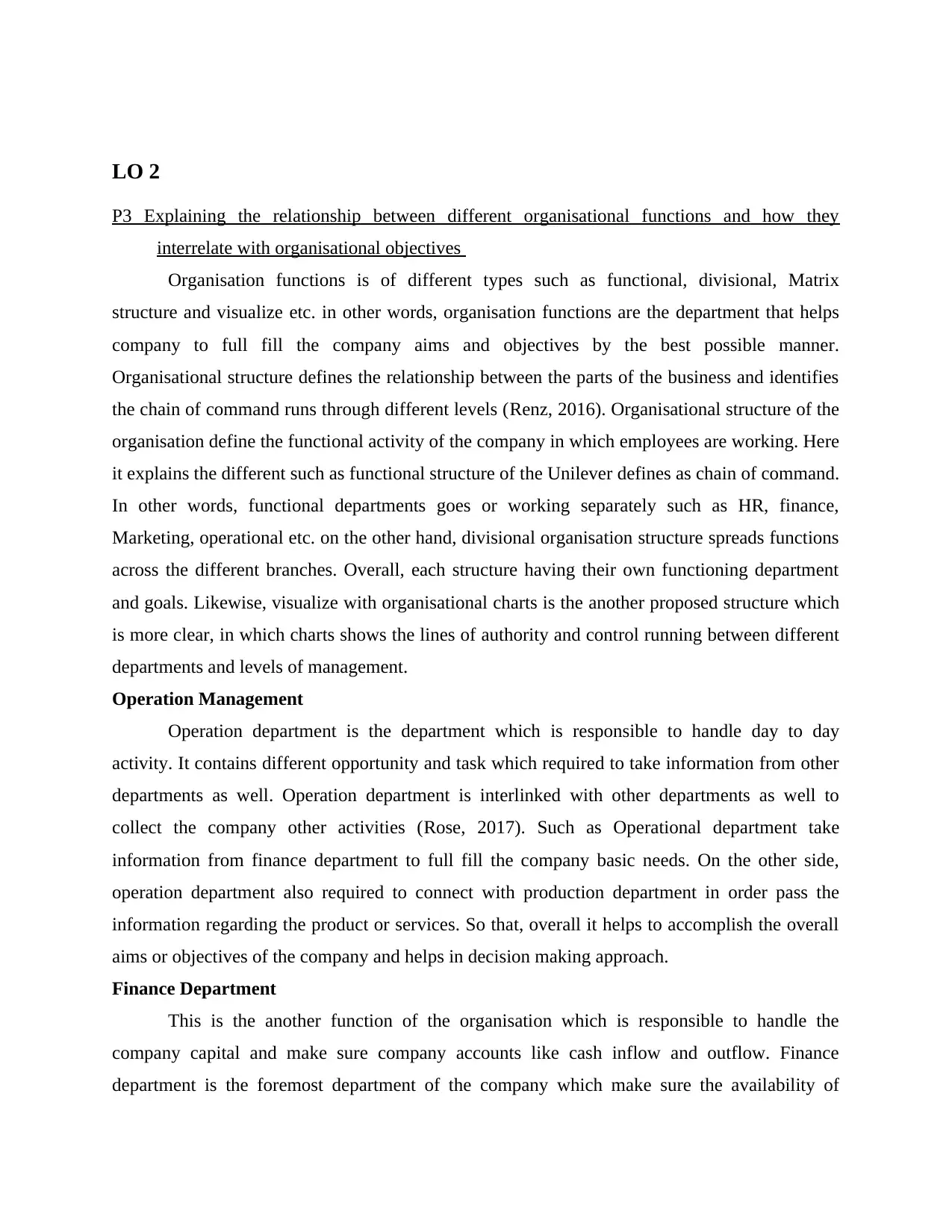
LO 2
P3 Explaining the relationship between different organisational functions and how they
interrelate with organisational objectives
Organisation functions is of different types such as functional, divisional, Matrix
structure and visualize etc. in other words, organisation functions are the department that helps
company to full fill the company aims and objectives by the best possible manner.
Organisational structure defines the relationship between the parts of the business and identifies
the chain of command runs through different levels (Renz, 2016). Organisational structure of the
organisation define the functional activity of the company in which employees are working. Here
it explains the different such as functional structure of the Unilever defines as chain of command.
In other words, functional departments goes or working separately such as HR, finance,
Marketing, operational etc. on the other hand, divisional organisation structure spreads functions
across the different branches. Overall, each structure having their own functioning department
and goals. Likewise, visualize with organisational charts is the another proposed structure which
is more clear, in which charts shows the lines of authority and control running between different
departments and levels of management.
Operation Management
Operation department is the department which is responsible to handle day to day
activity. It contains different opportunity and task which required to take information from other
departments as well. Operation department is interlinked with other departments as well to
collect the company other activities (Rose, 2017). Such as Operational department take
information from finance department to full fill the company basic needs. On the other side,
operation department also required to connect with production department in order pass the
information regarding the product or services. So that, overall it helps to accomplish the overall
aims or objectives of the company and helps in decision making approach.
Finance Department
This is the another function of the organisation which is responsible to handle the
company capital and make sure company accounts like cash inflow and outflow. Finance
department is the foremost department of the company which make sure the availability of
P3 Explaining the relationship between different organisational functions and how they
interrelate with organisational objectives
Organisation functions is of different types such as functional, divisional, Matrix
structure and visualize etc. in other words, organisation functions are the department that helps
company to full fill the company aims and objectives by the best possible manner.
Organisational structure defines the relationship between the parts of the business and identifies
the chain of command runs through different levels (Renz, 2016). Organisational structure of the
organisation define the functional activity of the company in which employees are working. Here
it explains the different such as functional structure of the Unilever defines as chain of command.
In other words, functional departments goes or working separately such as HR, finance,
Marketing, operational etc. on the other hand, divisional organisation structure spreads functions
across the different branches. Overall, each structure having their own functioning department
and goals. Likewise, visualize with organisational charts is the another proposed structure which
is more clear, in which charts shows the lines of authority and control running between different
departments and levels of management.
Operation Management
Operation department is the department which is responsible to handle day to day
activity. It contains different opportunity and task which required to take information from other
departments as well. Operation department is interlinked with other departments as well to
collect the company other activities (Rose, 2017). Such as Operational department take
information from finance department to full fill the company basic needs. On the other side,
operation department also required to connect with production department in order pass the
information regarding the product or services. So that, overall it helps to accomplish the overall
aims or objectives of the company and helps in decision making approach.
Finance Department
This is the another function of the organisation which is responsible to handle the
company capital and make sure company accounts like cash inflow and outflow. Finance
department is the foremost department of the company which make sure the availability of
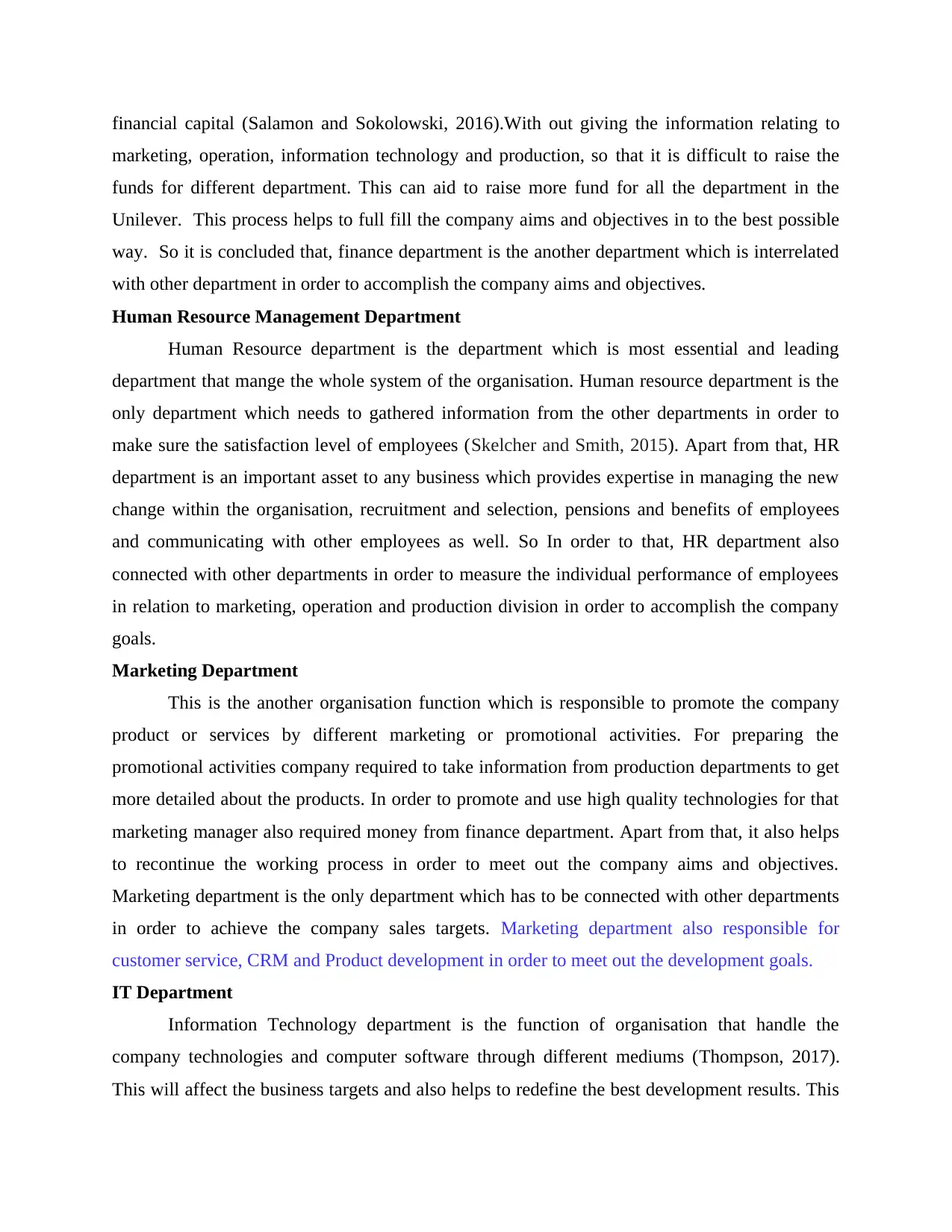
financial capital (Salamon and Sokolowski, 2016).With out giving the information relating to
marketing, operation, information technology and production, so that it is difficult to raise the
funds for different department. This can aid to raise more fund for all the department in the
Unilever. This process helps to full fill the company aims and objectives in to the best possible
way. So it is concluded that, finance department is the another department which is interrelated
with other department in order to accomplish the company aims and objectives.
Human Resource Management Department
Human Resource department is the department which is most essential and leading
department that mange the whole system of the organisation. Human resource department is the
only department which needs to gathered information from the other departments in order to
make sure the satisfaction level of employees (Skelcher and Smith, 2015). Apart from that, HR
department is an important asset to any business which provides expertise in managing the new
change within the organisation, recruitment and selection, pensions and benefits of employees
and communicating with other employees as well. So In order to that, HR department also
connected with other departments in order to measure the individual performance of employees
in relation to marketing, operation and production division in order to accomplish the company
goals.
Marketing Department
This is the another organisation function which is responsible to promote the company
product or services by different marketing or promotional activities. For preparing the
promotional activities company required to take information from production departments to get
more detailed about the products. In order to promote and use high quality technologies for that
marketing manager also required money from finance department. Apart from that, it also helps
to recontinue the working process in order to meet out the company aims and objectives.
Marketing department is the only department which has to be connected with other departments
in order to achieve the company sales targets. Marketing department also responsible for
customer service, CRM and Product development in order to meet out the development goals.
IT Department
Information Technology department is the function of organisation that handle the
company technologies and computer software through different mediums (Thompson, 2017).
This will affect the business targets and also helps to redefine the best development results. This
marketing, operation, information technology and production, so that it is difficult to raise the
funds for different department. This can aid to raise more fund for all the department in the
Unilever. This process helps to full fill the company aims and objectives in to the best possible
way. So it is concluded that, finance department is the another department which is interrelated
with other department in order to accomplish the company aims and objectives.
Human Resource Management Department
Human Resource department is the department which is most essential and leading
department that mange the whole system of the organisation. Human resource department is the
only department which needs to gathered information from the other departments in order to
make sure the satisfaction level of employees (Skelcher and Smith, 2015). Apart from that, HR
department is an important asset to any business which provides expertise in managing the new
change within the organisation, recruitment and selection, pensions and benefits of employees
and communicating with other employees as well. So In order to that, HR department also
connected with other departments in order to measure the individual performance of employees
in relation to marketing, operation and production division in order to accomplish the company
goals.
Marketing Department
This is the another organisation function which is responsible to promote the company
product or services by different marketing or promotional activities. For preparing the
promotional activities company required to take information from production departments to get
more detailed about the products. In order to promote and use high quality technologies for that
marketing manager also required money from finance department. Apart from that, it also helps
to recontinue the working process in order to meet out the company aims and objectives.
Marketing department is the only department which has to be connected with other departments
in order to achieve the company sales targets. Marketing department also responsible for
customer service, CRM and Product development in order to meet out the development goals.
IT Department
Information Technology department is the function of organisation that handle the
company technologies and computer software through different mediums (Thompson, 2017).
This will affect the business targets and also helps to redefine the best development results. This
⊘ This is a preview!⊘
Do you want full access?
Subscribe today to unlock all pages.

Trusted by 1+ million students worldwide
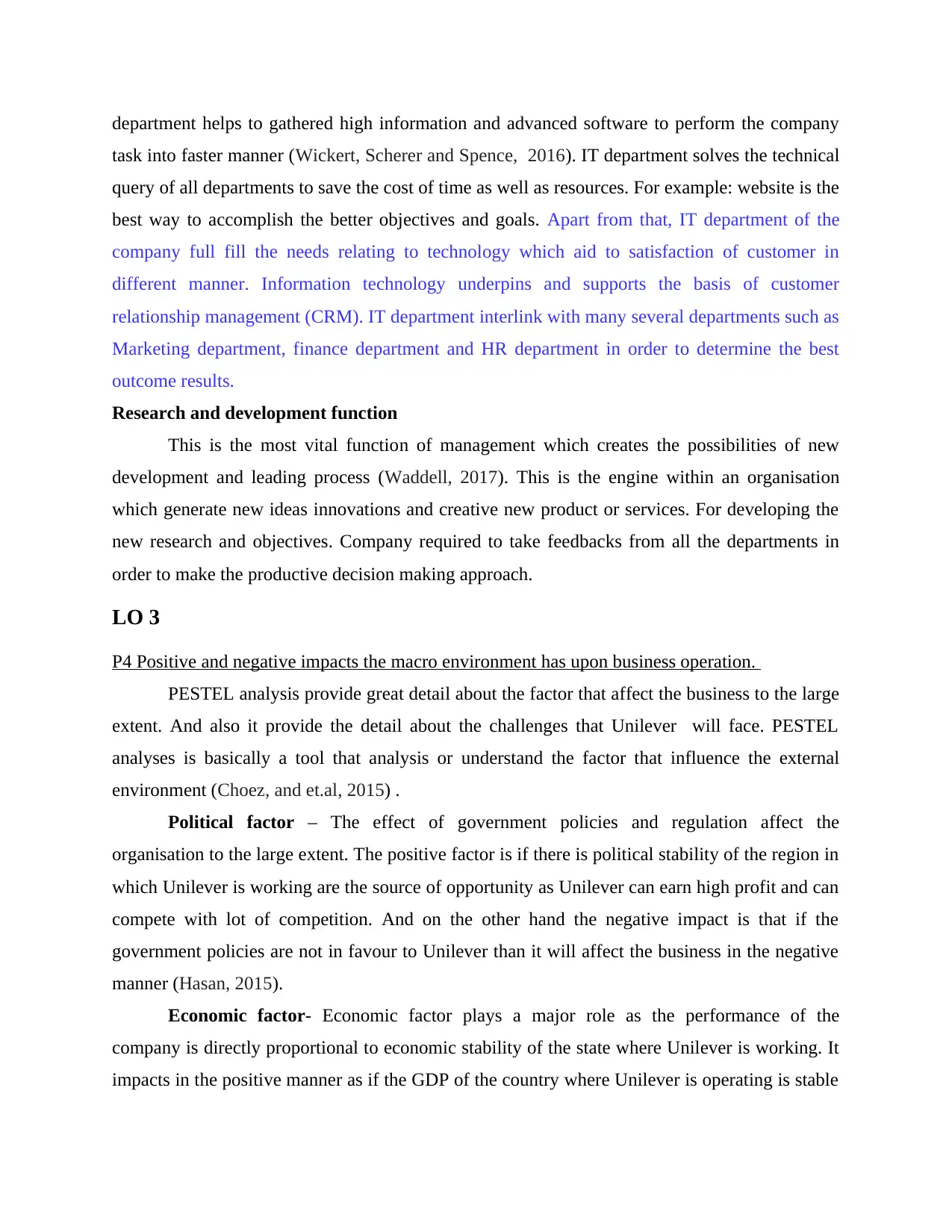
department helps to gathered high information and advanced software to perform the company
task into faster manner (Wickert, Scherer and Spence, 2016). IT department solves the technical
query of all departments to save the cost of time as well as resources. For example: website is the
best way to accomplish the better objectives and goals. Apart from that, IT department of the
company full fill the needs relating to technology which aid to satisfaction of customer in
different manner. Information technology underpins and supports the basis of customer
relationship management (CRM). IT department interlink with many several departments such as
Marketing department, finance department and HR department in order to determine the best
outcome results.
Research and development function
This is the most vital function of management which creates the possibilities of new
development and leading process (Waddell, 2017). This is the engine within an organisation
which generate new ideas innovations and creative new product or services. For developing the
new research and objectives. Company required to take feedbacks from all the departments in
order to make the productive decision making approach.
LO 3
P4 Positive and negative impacts the macro environment has upon business operation.
PESTEL analysis provide great detail about the factor that affect the business to the large
extent. And also it provide the detail about the challenges that Unilever will face. PESTEL
analyses is basically a tool that analysis or understand the factor that influence the external
environment (Choez, and et.al, 2015) .
Political factor – The effect of government policies and regulation affect the
organisation to the large extent. The positive factor is if there is political stability of the region in
which Unilever is working are the source of opportunity as Unilever can earn high profit and can
compete with lot of competition. And on the other hand the negative impact is that if the
government policies are not in favour to Unilever than it will affect the business in the negative
manner (Hasan, 2015).
Economic factor- Economic factor plays a major role as the performance of the
company is directly proportional to economic stability of the state where Unilever is working. It
impacts in the positive manner as if the GDP of the country where Unilever is operating is stable
task into faster manner (Wickert, Scherer and Spence, 2016). IT department solves the technical
query of all departments to save the cost of time as well as resources. For example: website is the
best way to accomplish the better objectives and goals. Apart from that, IT department of the
company full fill the needs relating to technology which aid to satisfaction of customer in
different manner. Information technology underpins and supports the basis of customer
relationship management (CRM). IT department interlink with many several departments such as
Marketing department, finance department and HR department in order to determine the best
outcome results.
Research and development function
This is the most vital function of management which creates the possibilities of new
development and leading process (Waddell, 2017). This is the engine within an organisation
which generate new ideas innovations and creative new product or services. For developing the
new research and objectives. Company required to take feedbacks from all the departments in
order to make the productive decision making approach.
LO 3
P4 Positive and negative impacts the macro environment has upon business operation.
PESTEL analysis provide great detail about the factor that affect the business to the large
extent. And also it provide the detail about the challenges that Unilever will face. PESTEL
analyses is basically a tool that analysis or understand the factor that influence the external
environment (Choez, and et.al, 2015) .
Political factor – The effect of government policies and regulation affect the
organisation to the large extent. The positive factor is if there is political stability of the region in
which Unilever is working are the source of opportunity as Unilever can earn high profit and can
compete with lot of competition. And on the other hand the negative impact is that if the
government policies are not in favour to Unilever than it will affect the business in the negative
manner (Hasan, 2015).
Economic factor- Economic factor plays a major role as the performance of the
company is directly proportional to economic stability of the state where Unilever is working. It
impacts in the positive manner as if the GDP of the country where Unilever is operating is stable
Paraphrase This Document
Need a fresh take? Get an instant paraphrase of this document with our AI Paraphraser
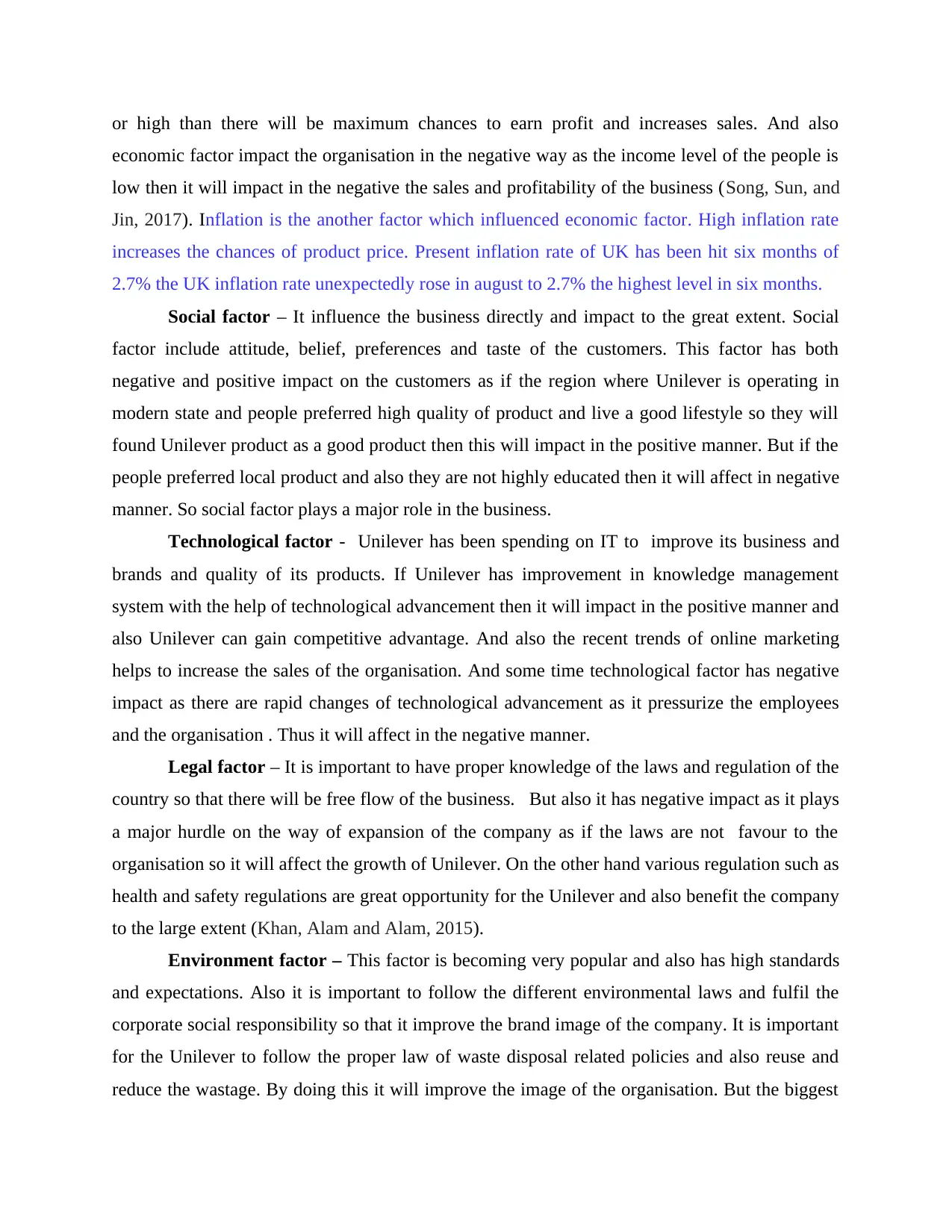
or high than there will be maximum chances to earn profit and increases sales. And also
economic factor impact the organisation in the negative way as the income level of the people is
low then it will impact in the negative the sales and profitability of the business (Song, Sun, and
Jin, 2017). Inflation is the another factor which influenced economic factor. High inflation rate
increases the chances of product price. Present inflation rate of UK has been hit six months of
2.7% the UK inflation rate unexpectedly rose in august to 2.7% the highest level in six months.
Social factor – It influence the business directly and impact to the great extent. Social
factor include attitude, belief, preferences and taste of the customers. This factor has both
negative and positive impact on the customers as if the region where Unilever is operating in
modern state and people preferred high quality of product and live a good lifestyle so they will
found Unilever product as a good product then this will impact in the positive manner. But if the
people preferred local product and also they are not highly educated then it will affect in negative
manner. So social factor plays a major role in the business.
Technological factor - Unilever has been spending on IT to improve its business and
brands and quality of its products. If Unilever has improvement in knowledge management
system with the help of technological advancement then it will impact in the positive manner and
also Unilever can gain competitive advantage. And also the recent trends of online marketing
helps to increase the sales of the organisation. And some time technological factor has negative
impact as there are rapid changes of technological advancement as it pressurize the employees
and the organisation . Thus it will affect in the negative manner.
Legal factor – It is important to have proper knowledge of the laws and regulation of the
country so that there will be free flow of the business. But also it has negative impact as it plays
a major hurdle on the way of expansion of the company as if the laws are not favour to the
organisation so it will affect the growth of Unilever. On the other hand various regulation such as
health and safety regulations are great opportunity for the Unilever and also benefit the company
to the large extent (Khan, Alam and Alam, 2015).
Environment factor – This factor is becoming very popular and also has high standards
and expectations. Also it is important to follow the different environmental laws and fulfil the
corporate social responsibility so that it improve the brand image of the company. It is important
for the Unilever to follow the proper law of waste disposal related policies and also reuse and
reduce the wastage. By doing this it will improve the image of the organisation. But the biggest
economic factor impact the organisation in the negative way as the income level of the people is
low then it will impact in the negative the sales and profitability of the business (Song, Sun, and
Jin, 2017). Inflation is the another factor which influenced economic factor. High inflation rate
increases the chances of product price. Present inflation rate of UK has been hit six months of
2.7% the UK inflation rate unexpectedly rose in august to 2.7% the highest level in six months.
Social factor – It influence the business directly and impact to the great extent. Social
factor include attitude, belief, preferences and taste of the customers. This factor has both
negative and positive impact on the customers as if the region where Unilever is operating in
modern state and people preferred high quality of product and live a good lifestyle so they will
found Unilever product as a good product then this will impact in the positive manner. But if the
people preferred local product and also they are not highly educated then it will affect in negative
manner. So social factor plays a major role in the business.
Technological factor - Unilever has been spending on IT to improve its business and
brands and quality of its products. If Unilever has improvement in knowledge management
system with the help of technological advancement then it will impact in the positive manner and
also Unilever can gain competitive advantage. And also the recent trends of online marketing
helps to increase the sales of the organisation. And some time technological factor has negative
impact as there are rapid changes of technological advancement as it pressurize the employees
and the organisation . Thus it will affect in the negative manner.
Legal factor – It is important to have proper knowledge of the laws and regulation of the
country so that there will be free flow of the business. But also it has negative impact as it plays
a major hurdle on the way of expansion of the company as if the laws are not favour to the
organisation so it will affect the growth of Unilever. On the other hand various regulation such as
health and safety regulations are great opportunity for the Unilever and also benefit the company
to the large extent (Khan, Alam and Alam, 2015).
Environment factor – This factor is becoming very popular and also has high standards
and expectations. Also it is important to follow the different environmental laws and fulfil the
corporate social responsibility so that it improve the brand image of the company. It is important
for the Unilever to follow the proper law of waste disposal related policies and also reuse and
reduce the wastage. By doing this it will improve the image of the organisation. But the biggest
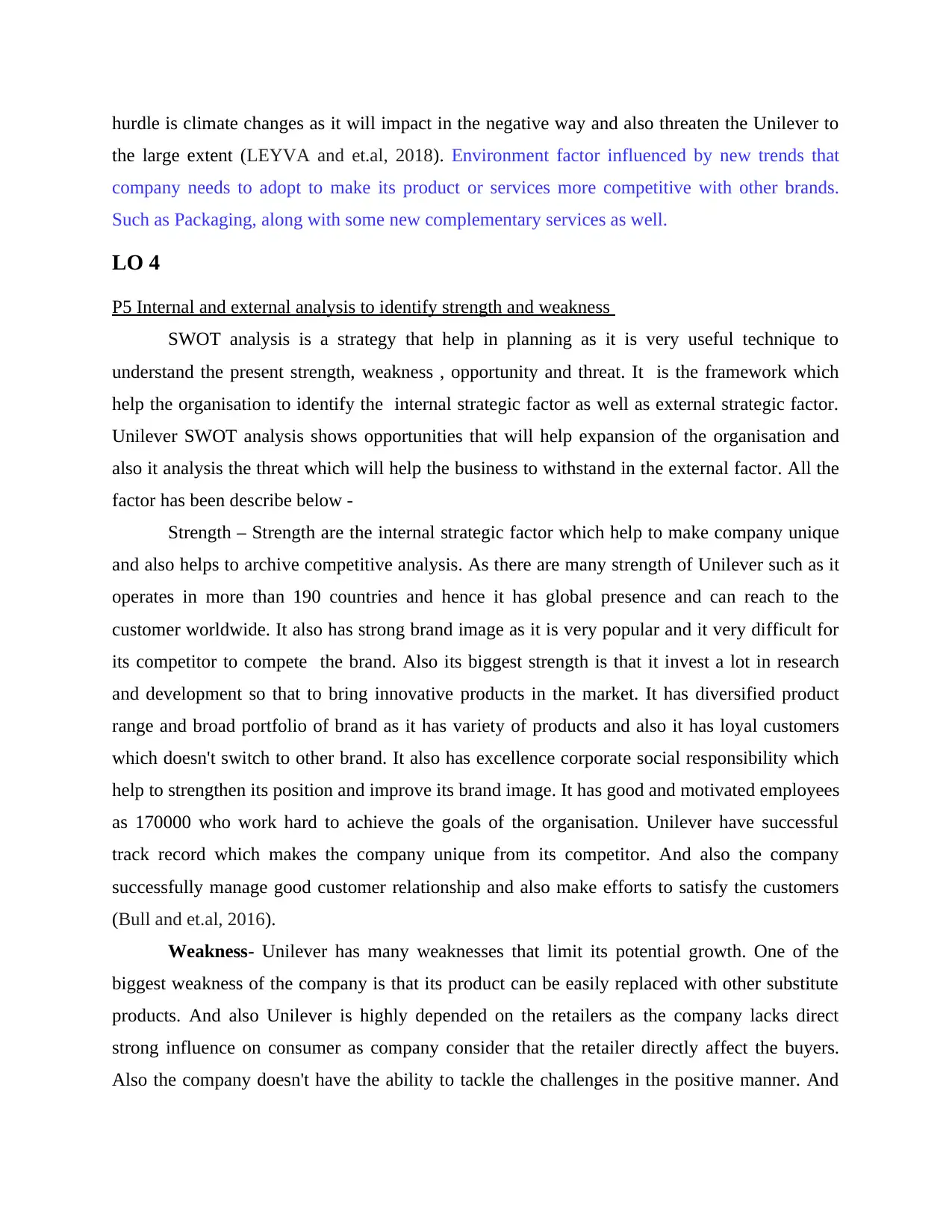
hurdle is climate changes as it will impact in the negative way and also threaten the Unilever to
the large extent (LEYVA and et.al, 2018). Environment factor influenced by new trends that
company needs to adopt to make its product or services more competitive with other brands.
Such as Packaging, along with some new complementary services as well.
LO 4
P5 Internal and external analysis to identify strength and weakness
SWOT analysis is a strategy that help in planning as it is very useful technique to
understand the present strength, weakness , opportunity and threat. It is the framework which
help the organisation to identify the internal strategic factor as well as external strategic factor.
Unilever SWOT analysis shows opportunities that will help expansion of the organisation and
also it analysis the threat which will help the business to withstand in the external factor. All the
factor has been describe below -
Strength – Strength are the internal strategic factor which help to make company unique
and also helps to archive competitive analysis. As there are many strength of Unilever such as it
operates in more than 190 countries and hence it has global presence and can reach to the
customer worldwide. It also has strong brand image as it is very popular and it very difficult for
its competitor to compete the brand. Also its biggest strength is that it invest a lot in research
and development so that to bring innovative products in the market. It has diversified product
range and broad portfolio of brand as it has variety of products and also it has loyal customers
which doesn't switch to other brand. It also has excellence corporate social responsibility which
help to strengthen its position and improve its brand image. It has good and motivated employees
as 170000 who work hard to achieve the goals of the organisation. Unilever have successful
track record which makes the company unique from its competitor. And also the company
successfully manage good customer relationship and also make efforts to satisfy the customers
(Bull and et.al, 2016).
Weakness- Unilever has many weaknesses that limit its potential growth. One of the
biggest weakness of the company is that its product can be easily replaced with other substitute
products. And also Unilever is highly depended on the retailers as the company lacks direct
strong influence on consumer as company consider that the retailer directly affect the buyers.
Also the company doesn't have the ability to tackle the challenges in the positive manner. And
the large extent (LEYVA and et.al, 2018). Environment factor influenced by new trends that
company needs to adopt to make its product or services more competitive with other brands.
Such as Packaging, along with some new complementary services as well.
LO 4
P5 Internal and external analysis to identify strength and weakness
SWOT analysis is a strategy that help in planning as it is very useful technique to
understand the present strength, weakness , opportunity and threat. It is the framework which
help the organisation to identify the internal strategic factor as well as external strategic factor.
Unilever SWOT analysis shows opportunities that will help expansion of the organisation and
also it analysis the threat which will help the business to withstand in the external factor. All the
factor has been describe below -
Strength – Strength are the internal strategic factor which help to make company unique
and also helps to archive competitive analysis. As there are many strength of Unilever such as it
operates in more than 190 countries and hence it has global presence and can reach to the
customer worldwide. It also has strong brand image as it is very popular and it very difficult for
its competitor to compete the brand. Also its biggest strength is that it invest a lot in research
and development so that to bring innovative products in the market. It has diversified product
range and broad portfolio of brand as it has variety of products and also it has loyal customers
which doesn't switch to other brand. It also has excellence corporate social responsibility which
help to strengthen its position and improve its brand image. It has good and motivated employees
as 170000 who work hard to achieve the goals of the organisation. Unilever have successful
track record which makes the company unique from its competitor. And also the company
successfully manage good customer relationship and also make efforts to satisfy the customers
(Bull and et.al, 2016).
Weakness- Unilever has many weaknesses that limit its potential growth. One of the
biggest weakness of the company is that its product can be easily replaced with other substitute
products. And also Unilever is highly depended on the retailers as the company lacks direct
strong influence on consumer as company consider that the retailer directly affect the buyers.
Also the company doesn't have the ability to tackle the challenges in the positive manner. And
⊘ This is a preview!⊘
Do you want full access?
Subscribe today to unlock all pages.

Trusted by 1+ million students worldwide
1 out of 17
Related Documents
Your All-in-One AI-Powered Toolkit for Academic Success.
+13062052269
info@desklib.com
Available 24*7 on WhatsApp / Email
![[object Object]](/_next/static/media/star-bottom.7253800d.svg)
Unlock your academic potential
Copyright © 2020–2025 A2Z Services. All Rights Reserved. Developed and managed by ZUCOL.





